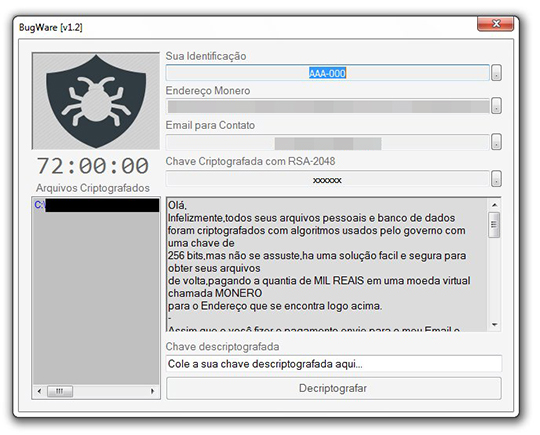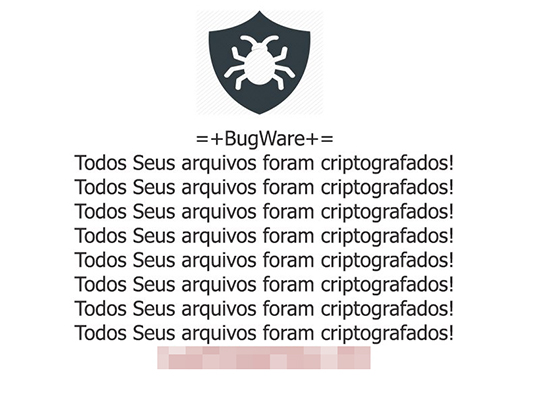RANSOM_HIDDENTEARBUGWARE.A
Trojan.Win32.Hesv.bg (Kaspersky); Trojan:Win32/Dynamer!rfn (Microsoft); Ransom.HiddenTear!g1 (Symantec)
Windows


Threat Type: Ransomware
Destructiveness: No
Encrypted: No
In the wild: Yes
OVERVIEW
Dropped by other malware, Downloaded from the Internet
This Ransomware arrives on a system as a file dropped by other malware or as a file downloaded unknowingly by users when visiting malicious sites.
It connects to certain websites to send and receive information.
It encrypts files with specific file extensions. It encrypts files found in specific folders.
TECHNICAL DETAILS
189,952 bytes
EXE
No
08 Oct 2017
Connects to URLs/IPs, Displays graphics/image, Displays message/message boxes, Encrypts files
Arrival Details
This Ransomware arrives on a system as a file dropped by other malware or as a file downloaded unknowingly by users when visiting malicious sites.
Installation
This Ransomware drops the following copies of itself into the affected system:
- %User Temp%\{Malware Name}
- {Removable Drive}\fatura-vencida.pdf.scr
(Note: %User Temp% is the user's temporary folder, where it usually is C:\Documents and Settings\{user name}\Local Settings\Temp on Windows 2000, Windows Server 2003, and Windows XP (32- and 64-bit); C:\Users\{user name}\AppData\Local\Temp on Windows Vista (32- and 64-bit), Windows 7 (32- and 64-bit), Windows 8 (32- and 64-bit), Windows 8.1 (32- and 64-bit), Windows Server 2008, and Windows Server 2012.)
It drops the following files:
- %AppDataLocal%\Lista.log -> list of encrypted files
(Note: %AppDataLocal% is the Application Data folder found in Local Settings, where it is usually C:\Documents and Settings\{user name}\Local Settings\Application Data on Windows 2000, Windows Server 2003, and Windows XP (32- and 64-bit); C:\Users\{user name}\AppData\Local on Windows Vista (32- and 64-bit), Windows 7 (32- and 64-bit), Windows 8 (32- and 64-bit), Windows 8.1 (32- and 64-bit), Windows Server 2008, and Windows Server 2012.)
It adds the following mutexes to ensure that only one of its copies runs at any one time:
- BuGWarE
Autostart Technique
This Ransomware adds the following registry entries to enable its automatic execution at every system startup:
HKEY_CURRENT_USER\SOFTWARE\Microsoft\
Windows\CurrentVersion\Run
BUGWARE = "%User Temp%\{Malware Name}"
Other System Modifications
This Ransomware adds the following registry entries as part of its installation routine:
HKEY_CURRENT_USER\SOFTWARE\BUGWARE
chavepriv8 = "{Encryption Key}"
HKEY_CURRENT_USER\SOFTWARE\BUGWARE
prazo = "{3 days after encryption}"
HKEY_CURRENT_USER\SOFTWARE\BUGWARE
ID = "{Volume Serial Number}"
HKEY_CURRENT_USER\SOFTWARE\BUGWARE
arquivos = "{Number of Encrypted Files}"
HKEY_CURRENT_USER\SOFTWARE\BUGWARE
enviado = "{(1/0) whether C&C connection was established}"
It changes the desktop wallpaper by modifying the following registry entries:
HKEY_CURRENT_USER\Control Panel\Desktop
Wallpaper = "%Desktop%\bugware.bmp"
HKEY_CURRENT_USER\Control Panel\Desktop
WallpaperStyle = 2
HKEY_CURRENT_USER\Control Panel\Desktop
TileWallpaper = 0
It sets the system's desktop wallpaper to the following image:
Download Routine
This Ransomware downloads the file from the following URL and renames the file when stored in the affected system:
- https://i.{BLOCKED}r.com/NpKQ3KZ.jpg
It saves the files it downloads using the following names:
- %Desktop%\bugware.bmp -> wallpaper
(Note: %Desktop% is the desktop folder, where it usually is C:\Documents and Settings\{user name}\Desktop in Windows 2000, Windows Server 2003, and Windows XP (32- and 64-bit); C:\Users\{user name}\Desktop in Windows Vista (32- and 64-bit), Windows 7 (32- and 64-bit), Windows 8 (32- and 64-bit), Windows 8.1 (32- and 64-bit), Windows Server 2008, and Windows Server 2012.)
Other Details
This Ransomware connects to the following website to send and receive information:
- http://{BLOCKED}hordietryin.xyz/sender.php
- http://www.{BLOCKED}rdrandom.com/query?command=guid
It displays a pop-up window with the following message:

It does the following:
- It closes the application if the following file exists:
- %AppDataLocal%\Lista.log
- It deletes all encrypted files after 3 days if ransom is not paid
(Note: %AppDataLocal% is the Application Data folder found in Local Settings, where it is usually C:\Documents and Settings\{user name}\Local Settings\Application Data on Windows 2000, Windows Server 2003, and Windows XP (32- and 64-bit); C:\Users\{user name}\AppData\Local on Windows Vista (32- and 64-bit), Windows 7 (32- and 64-bit), Windows 8 (32- and 64-bit), Windows 8.1 (32- and 64-bit), Windows Server 2008, and Windows Server 2012.)
Ransomware Routine
This Ransomware encrypts files with the following extensions:
- .odt
- .ods
- .odp
- .odm
- .odc
- .odb
- .doc
- .docx
- .docm
- .wps
- .xls
- .xlsx
- .xlsm
- .xlsb
- .xlk
- .ppt
- .pptx
- .pptm
- .mdb
- .accdb
- .pst
- .dwg
- .xf
- .dxg
- .wpd
- .rtf
- .wb2
- .mdf
- .dbf
- .psd
- .pdd
- .eps
- .ai
- .indd
- .cdr
- .jpg
- .jpe
- .dng
- .3fr
- .arw
- .srf
- .sr2
- .bay
- .crw
- .cr2
- .dcr
- .kdc
- .erf
- .mef
- .mrwref
- .nrw
- .orf
- .raf
- .raw
- .rwl
- .rw2
- .r3d
- .ptx
- .pef
- .srw
- .x3f
- .der
- .cer
- .crt
- .pem
- .pfx
- .p12
- .p7b
- .p7c
- .c
- .cpp
- .txt
- .jpeg
- .png
- .gif
- .mp3
- .html
- .css
- .js
- .sql
- .mp4
- .flv
- .m3u
- .py
- .desc
- .con
- .htm
- .bin
- .wotreplay
- .unity3d
- .big
- .pak
- .rgss3a
- .epk
- .bik
- .slm
- .lbf
- .sav
- .lng
- .ttarch2
- .mpq
- .re4
- .apk
- .bsa
- .cab
- .ltx
- .forge
- .asset
- .litemod
- .iwi
- .das
- .upk
- .bar
- .hkx
- .rofl
- .DayZProfile
- .db0
- .mpqge
- .vfs0
- .mcmeta
- .m2
- .lrf
- .vpp_pc
- .ff
- .cfr
- .snx
- .lvl
- .arch00
- .ntl
- .fsh
- .w3x
- .rim
- psk
- .tor
- .vpk
- .iwd
- .kf
- .mlx
- .fpk
- .zip
- .vtf
- .001
- .esm
- .blob
- .dmp
- .layout
- .menu
- .ncf
- .sid
- .sis
- .ztmp
- .vdf
- .mcgame
- .fos
- .sb
- .im
- .wmo
- .itm
- .map
- .wmo
- .sb
- .svg
- .cas
- .gho
- .iso
- .rar
- .syncdb
- .mdbackup
- .hkdb
- .hplg
- .hvpl
- .icxs
- .itdb
- .itl
- .mddata
- .sidd
- .sidn
- .bkf
- .qic
- .bkp
- .bc7
- .bc6
- .pkpass
- .tax
- .gdb
- .qdf
- .t12
- .t13
- .ibank
- .sum
- .sie
- .sc2save
- .d3dbsp
- .wmv
- .avi
- .wma
- .m4a
- .7z
- .torrent
- .csv
- .cs
- .jar
- .java
- .class
- .rar
- .wav
- .asp
- .aspx
- .php
- .sqlite3
It encrypts files found in the following folders:
- %Desktop%
- %User Profile%\Documents
- %User Profile%\Personal
- %User Profile%\MyMusic
- %User Profile%\MyPictures
- %User Profile%\MyVideos
- logical drives
- fixed
- removable
- network
(Note: %Desktop% is the desktop folder, where it usually is C:\Documents and Settings\{user name}\Desktop in Windows 2000, Windows Server 2003, and Windows XP (32- and 64-bit); C:\Users\{user name}\Desktop in Windows Vista (32- and 64-bit), Windows 7 (32- and 64-bit), Windows 8 (32- and 64-bit), Windows 8.1 (32- and 64-bit), Windows Server 2008, and Windows Server 2012.. %User Profile% is the current user's profile folder, which is usually C:\Documents and Settings\{user name} on Windows 2000, XP, and Server 2003, or C:\Users\{user name} on Windows Vista and 7.)
It avoids encrypting files with the following strings in their file path:
- %Program Files%
- %ProgramData%
- %Windows%
- %Application Data%
- %AppDataLocal%
- $recycle.bin
- intel
- nvidia
(Note: %Program Files% is the Program Files folder, where it usually is C:\Program Files on all Windows operating system versions; C:\Program Files (x86) for 32-bit applications running on Windows 64-bit operating systems.. %ProgramData% is the Program Data folder, where it usually is C:\Program Files in Windows 2000, Windows Server 2003, and Windows XP (32- and 64-bit); C:\ProgramData in Windows Vista (32- and 64-bit), Windows 7 (32- and 64-bit), Windows 8 (32- and 64-bit), Windows 8.1 (32- and 64-bit), Windows Server 2008, and Windows Server 2012.. %Windows% is the Windows folder, where it usually is C:\Windows on all Windows operating system versions.. %Application Data% is the Application Data folder, where it usually is C:\Documents and Settings\{user name}\Application Data on Windows 2000, Windows Server 2003, and Windows XP (32- and 64-bit); C:\Users\{user name}\AppData\Roaming on Windows Vista (32- and 64-bit), Windows 7 (32- and 64-bit), Windows 8 (32- and 64-bit), Windows 8.1 (32- and 64-bit), Windows Server 2008, and Windows Server 2012.. %AppDataLocal% is the Application Data folder found in Local Settings, where it is usually C:\Documents and Settings\{user name}\Local Settings\Application Data on Windows 2000, Windows Server 2003, and Windows XP (32- and 64-bit); C:\Users\{user name}\AppData\Local on Windows Vista (32- and 64-bit), Windows 7 (32- and 64-bit), Windows 8 (32- and 64-bit), Windows 8.1 (32- and 64-bit), Windows Server 2008, and Windows Server 2012.)
It appends the following extension to the file name of the encrypted files:
- .[SLAVIC@{BLOCKED}L.PRO].BUGWARE
SOLUTION
9.850
13.712.04
08 Oct 2017
13.713.00
09 Oct 2017
Step 1
Before doing any scans, Windows XP, Windows Vista, and Windows 7 users must disable System Restore to allow full scanning of their computers.
Step 2
Note that not all files, folders, and registry keys and entries are installed on your computer during this malware's/spyware's/grayware's execution. This may be due to incomplete installation or other operating system conditions. If you do not find the same files/folders/registry information, please proceed to the next step.
Step 3
Identify and terminate files detected as RANSOM_HIDDENTEARBUGWARE.A
- Windows Task Manager may not display all running processes. In this case, please use a third-party process viewer, preferably Process Explorer, to terminate the malware/grayware/spyware file. You may download the said tool here.
- If the detected file is displayed in either Windows Task Manager or Process Explorer but you cannot delete it, restart your computer in safe mode. To do this, refer to this link for the complete steps.
- If the detected file is not displayed in either Windows Task Manager or Process Explorer, continue doing the next steps.
Step 4
Delete this registry key
Important: Editing the Windows Registry incorrectly can lead to irreversible system malfunction. Please do this step only if you know how or you can ask assistance from your system administrator. Else, check this Microsoft article first before modifying your computer's registry.
- In HKEY_CURRENT_USER\SOFTWARE
- BUGWARE
- BUGWARE
Step 5
Delete this registry value
Important: Editing the Windows Registry incorrectly can lead to irreversible system malfunction. Please do this step only if you know how or you can ask assistance from your system administrator. Else, check this Microsoft article first before modifying your computer's registry.
- In HKEY_CURRENT_USER\SOFTWARE\Microsoft\Windows\CurrentVersion\Run
- BUGWARE = "%User Temp%\{Malware Name}"
- BUGWARE = "%User Temp%\{Malware Name}"
Step 6
Search and delete these files
- %AppDataLocal%\Lista.log
- %Desktop%\bugware.bmp
Step 7
Scan your computer with your Trend Micro product to delete files detected as RANSOM_HIDDENTEARBUGWARE.A. If the detected files have already been cleaned, deleted, or quarantined by your Trend Micro product, no further step is required. You may opt to simply delete the quarantined files. Please check this Knowledge Base page for more information.
Step 8
Reset your Desktop properties
Step 9
Restore encrypted files from backup.
Did this description help? Tell us how we did.


